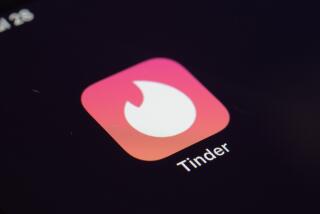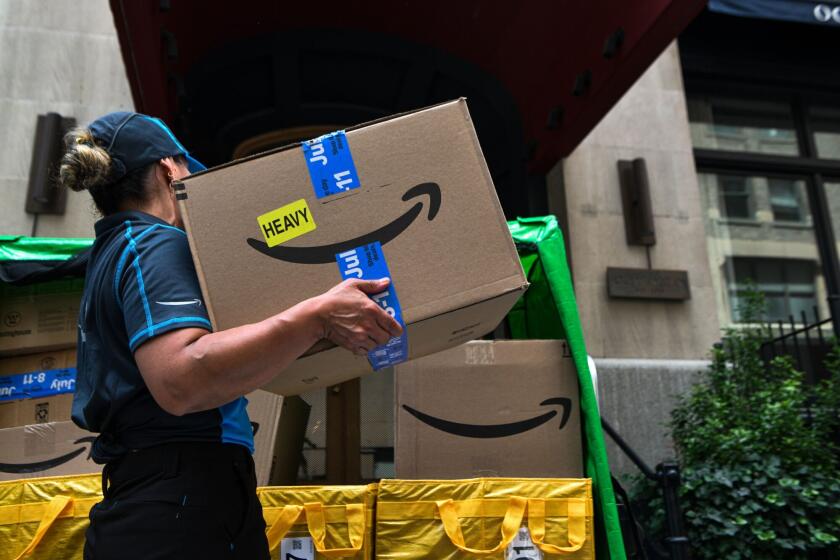Tinder matchmaking app evolves to moneymaking
- Share via
Popular for its matchmaking ability, the rapidly growing dating app Tinder on Thursday launched its first effort at moneymaking.
After seeing Tinder’s monthly user numbers explode seven times over during the last year, the West Hollywood start-up’s majority owner is anxiously waiting for its investment to yield hundreds of millions of dollars in annual revenue.
In its first experiment with making money, Tinder said Thursday that it would charge its mostly millennial users for special features through a subscription plan called Tinder Plus. The plan is to make it available to all Tinder users by the end of the year.
Greg Blatt, chief executive of majority owner IAC Corp., recently said advertising probably would come later. Though IAC has produced healthy profit margins through dating websites such as Match.com, the young, fickle and mobile-phone-using audience for Tinder marks a delicate challenge.
“You don’t just flip a switch on monetization,” Blatt told analysts last week. “There is a playbook. You have a bunch of things to try.... So I won’t say that in two weeks it will be perfect, but we have high degree of confidence in the multiyear monetization of Tinder.”
The prospects are soaring, according to analysts who follow IAC.
“Tinder is the fastest-growing dating app in existence,” said Victor Anthony, an Internet media analyst at Topeka Capital Markets. “If IAC can get the pricing right, the revenue and profit potential will be significant.”
The app has consistently ranked among the most-downloaded lifestyle apps on the Apple and Google Play app stores since launching two years ago, according to data from AppAnnie. Users log in to Tinder with their Facebook profile, select preferences such as age and gender for potential partners and then, one by one, flick through a list of matches. When two people approve of each other, they can privately message within the app.
The paid features are the two options most requested by users, said Tinder spokeswoman Rosette Pambakian.
Called Undo and Passport, they allow users to recall a profile that they may have accidentally rejected and to see potential mates from an area outside the typical 120-mile zone.
“You wouldn’t believe the number of people who email us asking if they can bring someone back,” Pambakian said. And with Passport, she said, users going on vacation or business trips can connect with people in their destination amid planning or while waiting for a flight.
Pricing for the package is being tested, from $1.99 to $19.99, across seven countries overseas including Britain, Brazil and Germany. About two in three Tinder users are outside the U.S., according to IAC.
“This stuff is not religion,” Blatt said. “This is stuff you optimize your way into.”
The cautious approach lessens the chance that Tinder will be burned by its users for ruining the app’s quick-swipe user interface, which has spawned dozens of copycats in dating and other industries.
Jason Helfstein, an analyst at Oppenheimer Co., called Tinder Plus a no-brainer approach since it provides exactly what’s desired from users.
“Now, let’s see how much and how many people will pay for it,” he said. “A year from now, they’ll have solidified those products and then can say, ‘What sort of advertising can we get in there between swipes?’”
Besides advertising, Tinder is aiming for a bigger role in the zeitgeist. The company plans to invite a group of celebrities to create profiles to connect with fans beginning next year, and it’s possible the company could eventually produce market research by analyzing the data it collects about individual preferences.
Still, IAC’s Blatt said subscriptions should be the biggest chunk of revenue, with “a meaningful number of people who will pay extra.” IAC has about 3.6 million subscribers for its dating services, up more than 7% during the last year.
Tinder says it has 30 million accounts on its network and connects 14 million pairs each day.
Kevin Rippey, an analyst at Maxim Group, estimates that nearly 24 million are active users. Assuming 60 million users by 2016, Rippey projected Tinder would bring in $150 million in revenue that year. IAC’s dating websites, including Match.com and OkCupid, brought in $788 million in 2013.
The testing of Tinder Plus comes at a crucial juncture. The company is searching for a new chief executive as current CEO Sean Rad transitions to president. Rad, who formed the start-up with friends and business partners within an IAC incubator program in 2012, said he would continue to focus on product and brand development.
Helfstein, the Oppenheimer analyst, compared the management shake-up to veteran Google executive Sheryl Sandberg joining young, brilliant but inexperienced manager Mark Zuckerberg at Facebook. Rad was caught up in a sexual harassment and discrimination lawsuit this summer lodged by a former executive.
Though the case was settled, legal costs were among the reasons IAC had to invest an extra $10 million into Tinder this year. And bringing someone older into the room offers comfort to IAC’s investors that the hot property is in capable hands.
“IAC has voiced intentions of spinning off the Match Group [of dating services], and it’s important if you’re asking public investors to invest in that to assure that it’s professionally managed,” Helfstein said.
Chat with me on Twitter @peard33







